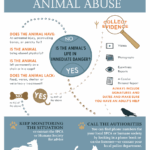Animal cruelty is an abhorrent reality that persists in various forms across the globe, eliciting a visceral reaction from those who bear witness to its manifestation. Picture this: a neglected dog, tethered to a rusted doghouse, weathering the elements without shelter. Or consider the countless farm animals confined in cramped, unsanitary conditions, stripped of the basic freedoms that any living being deserves. It begs the question: when will animal cruelty come to an end? To address this profoundly troubling issue, we must first explore the intricate tapestry of societal values, cultural norms, and legislative frameworks that contribute to the pervasive state of animal suffering.
In contemplating the cessation of animal cruelty, one cannot overlook the pervasive apathy that often colors human interactions with animals. This desensitization stems from various underlying factors, including sociocultural conditioning and economic priorities that prioritize profit over empathy. For example, the commodification of animals for food, entertainment, and experimentation has entrenched a mindset that views them as mere resources rather than sentient beings entitled to kindness and respect. Addressing these entrenched beliefs is essential in nurturing a society that prioritizes compassion over cruelty.
Moreover, the influence of media cannot be understated. Graphic depictions of animal suffering flood news cycles and social platforms, leading to a dichotomy: while some are motivated to advocate for change, others may become desensitized, viewing these images as mere spectacle. It is vital to reshape this narrative. By focusing on stories of rescue, recovery, and hope, media can play a pivotal role in instilling a deeper understanding of the emotional and cognitive capacities of animals, fostering empathy and prompting action.
Another avenue toward fostering a kinder future for animals lies in education. Schools and community programs that integrate animal welfare into their curricula can have a profound impact on the next generation. Understanding the ethical implications of our choices and the importance of empathy can transform future behaviors. Educational initiatives might include interactive programs with local shelters, teaching children about responsible pet ownership, humane treatment, and the interconnectedness of all living beings. Knowledge is a powerful catalyst for change; therefore, investing in educational systems that emphasize compassion and respect for animal life is paramount.
Legislation, too, plays an instrumental role in the fight against animal cruelty. Comprehensive laws that protect animals are vital; however, the enforcement of these laws often leaves much to be desired. As it stands, many jurisdictions lack the necessary resources to effectively monitor and prosecute cases of animal abuse. Strengthening animal cruelty laws, and ensuring that they are enforced with rigor, is crucial. Furthermore, collaboration among lawmakers, animal welfare organizations, and the general public can create a robust framework for advocacy that holds abusers accountable and emphasizes the need for preventive measures.
Encouraging societal shifts in how individuals perceive pet ownership can also contribute significantly to reducing animal cruelty. The antiquated notion that pets are possessions rather than family members results in neglect and abuse. Promoting the concept of responsible pet ownership — which encompasses spaying and neutering, regular veterinary care, and lifetime commitment — should be central to outreach initiatives. By fostering a sense of accountability, individuals are more likely to prioritize their pets’ well-being and advocate for the welfare of animals in their communities.
The importance of fostering a community of advocates cannot be overstated. Grassroots organizations, local volunteers, and national movements all contribute to a collective consciousness that prioritizes animal welfare. By mobilizing communities to support local shelters, participate in rescue operations, and promote spay/neuter projects, individuals can collectively address the root causes of animal cruelty. This collaborative approach also fosters a sense of belonging and shared purpose, which is essential in combatting the isolation often felt by those who oppose cruelty.
In the realm of animal agriculture, a significant shift toward ethical farming practices is imperative. Many consumers are increasingly interested in the origins of their food, leading to an upsurge in humane farming practices that consider the welfare of animals. Transparency in food production can drive consumer demand towards cruelty-free products, thereby influencing agricultural practices. Supporting local farms that prioritize ethical treatment can significantly impact the overall landscape of animal welfare on a larger scale.
Moreover, the rise of plant-based diets and alternative protein sources promises to reduce dependency on animal agriculture. As technology advances, more individuals are opting for vegan or vegetarian lifestyles, in turn minimizing demand for cruel farming practices. Public awareness campaigns highlighting the environmental and ethical implications of dietary choices pave the way for a future where animal cruelty is not only discouraged but practically obsolete.
Lastly, it is crucial to not overlook the role of individuals who take a stand against cruelty on a personal level. One can begin in small ways, such as advocating for adoption rather than purchase, supporting ethical brands, or even volunteering at local shelters. Every action, no matter how minor it may seem, contributes to a broader movement towards empathy and kindness. Additionally, sharing personal stories and promoting discussions about animal welfare can inspire others to reflect on their practices and make conscientious choices.
Ultimately, the quest to end animal cruelty is a multifaceted endeavor that necessitates the concerted efforts of individuals, communities, and governments. By fostering education, advocating for robust legislation, promoting humane practices, and cultivating a culture of compassion, we inch closer to a future where animal cruelty is a relic of the past. As we continue this essential work, it is paramount to recognize the profound connection between humans and animals — a connection that binds us in our shared responsibility to foster a world where all beings can coexist in harmony, free from harm and suffering.






